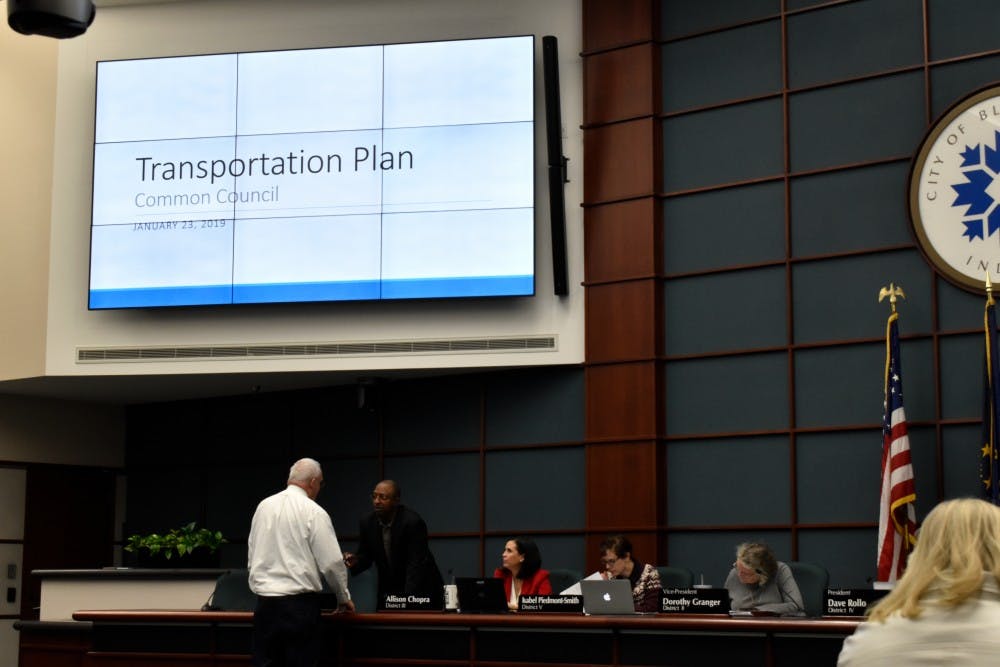The Bloomington City Council decided Wednesday night to postpone the transportation plan vote until the spring to allow for amendment submission.
Council president Dave Rollo said the previous schedule to send in amendments by Feb. 13 and vote on the plan by Feb. 27 was too little time to fully formulate and discuss changes. New deadlines have yet to be set.
The council has spent the past three meetings hearing details of the plan, which was created by city-hired firm Toole Design Group.
The transportation plan is an amendment to the Comprehensive Plan, the city’s latest long-term strategy for land use and development. The transportation plan proposes 67 new street connections, potential widening of some streets and further study on how to improve heavily trafficked streets for bikers and pedestrians.
“It could be improved dramatically,” Rollo said of the plan at his constituents meeting Saturday morning.
Criticisms of the plan has ranged from the the feasibility of changes to street widths to the plan not being rigorous enough in addressing climate change and getting cars off the road.
“It’s divorced from reality,” Peter Dorfman, Bloomington resident said at a Jan. 30 meeting.
Dorfman, who lives in the Near West Side neighborhood, and said the proposed widening of Maple Street alarmed him and his neighbors. Some houses on Maple Street are built close to the road, and widening the road could force some houses to be removed.
The changes to the street would also alter its character significantly, Dorfman said, with more traffic going through the quiet neighborhood.
Complete streets, which aim to make streets accessible to all forms of transportation and people of all ages and abilities, are part of the plan’s methodology. This approach, however, does not benefit the streets’ residents, said Frank Marshalek, another resident from the Near West Side.
“What kind of say do we have?” Marshalek said. “How can we protect our children who are playing in the front yards?”
Any resident can propose amendments to the council until it decides to set a due date. The council members will then choose whether to sponsor amendments or not.
At the Jan. 30 city council meeting, Beth Rosenbarger, planning services manager for the city’s Planning and Transportation Department, said the city staff has already discussed their own changes to the plan.
The Planning and Transportation Department wants to change the plan so existing neighborhood residential streets will not have to be widened and buildings will not need to be removed.
If this change is implemented, only sidewalk or trees would be added if the road were to be widened, Rosenbarger said. She said the city’s intent is not to take down houses, and this proposed change would clarify that.
The transportation and planning staff also is looking to change some of the assigned street labels to better match street use.
The proposed biking and pedestrian lanes and pathways received less criticism and more support from the council and public. Many supported the protected bike lane on Third Street, where cars often idle in the bike lane to drop off and pick up students.
Bike parking was not included in the plan, councilmember Isabel Piedmont-Smith said.
Bloomington resident Daniel Bingham said the plan will not do enough to address climate change. He said it will not do enough to keep cars off of the roads.
“There’s a hammer hanging over our head, and we need to act like it’s there,” Bingham said.
Another issue raised multiple times was that the plan does not include any new plans for Bloomington Transit, which is a separate entity from the Planning and Transportation Department. One resident voiced the need to talk to bus drivers when planning street width.
Jenny Southern, one of Rollo’s constituents, said the plan seemed to have been made completely backwards.
She said the consultants should have included neighborhoods in the planning to ensure the city’s feel was preserved.
“Instead of Bloomington getting less and less Bloomington, it could get more and more Bloomington,” Southern said. “The idiosyncrasies of a place are what make it a place.”




